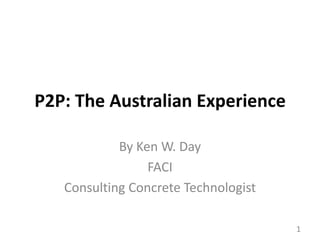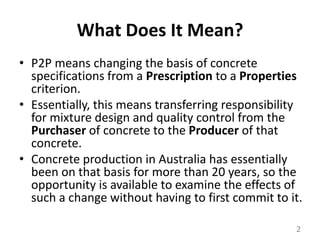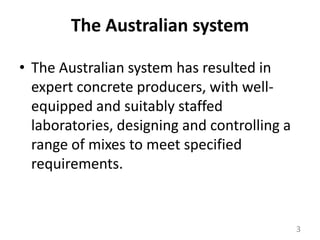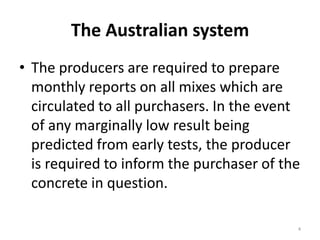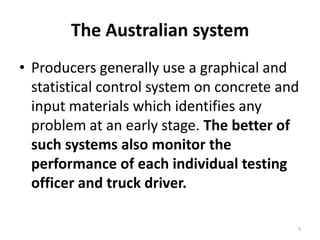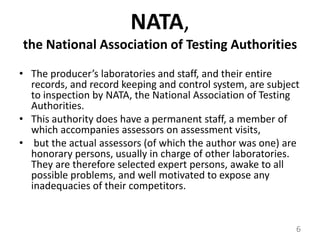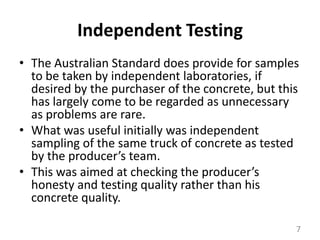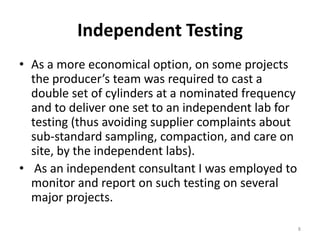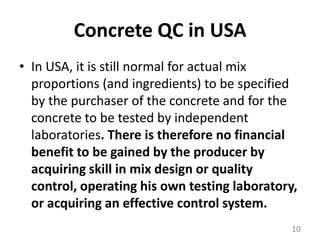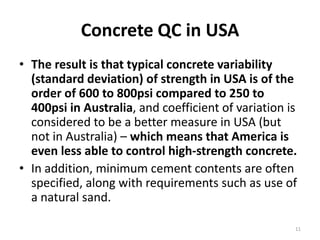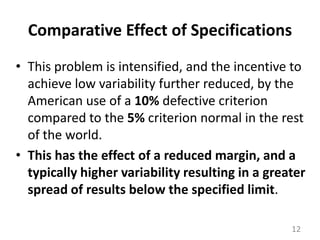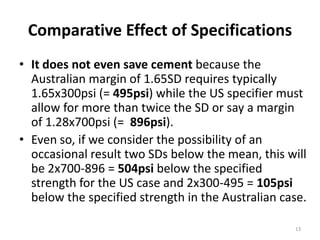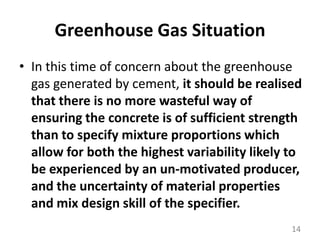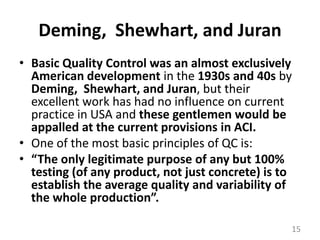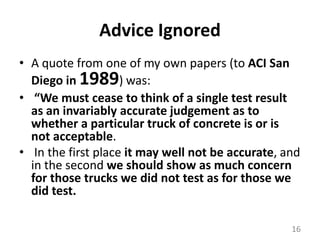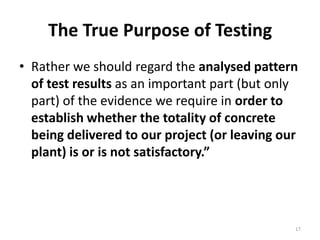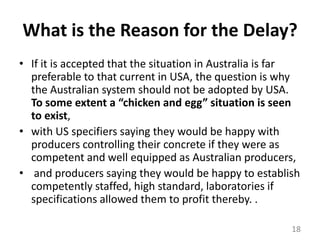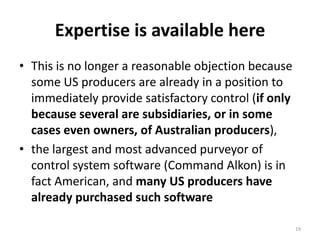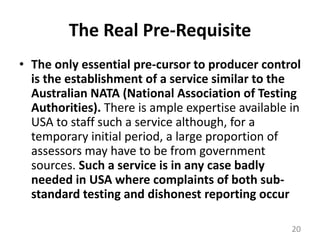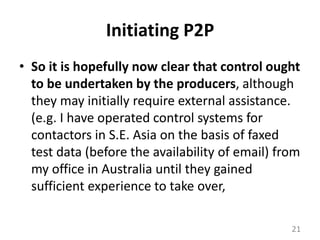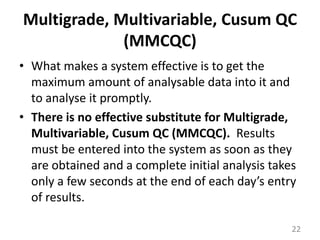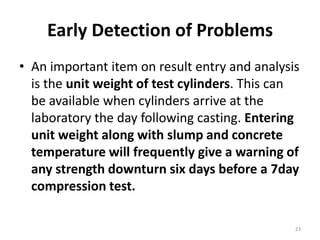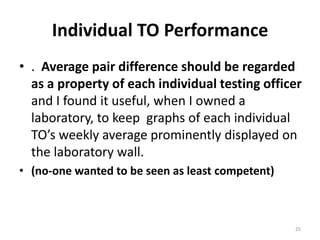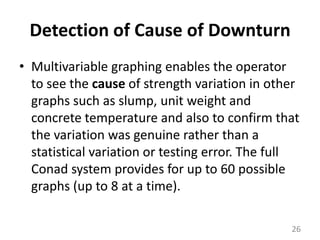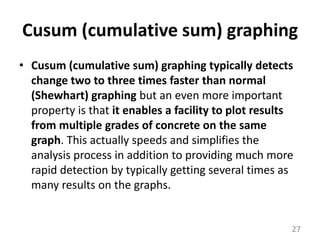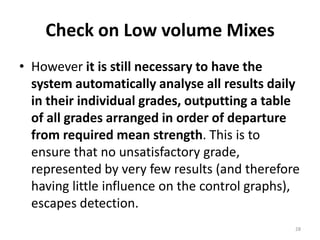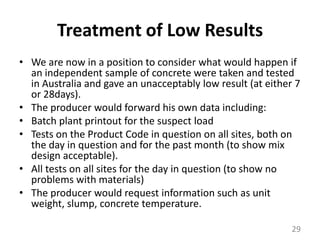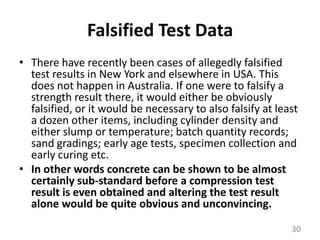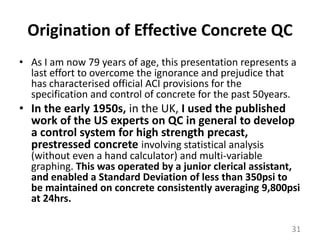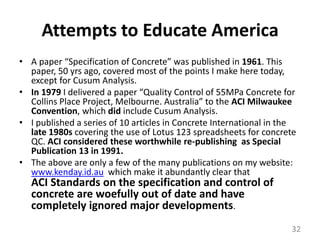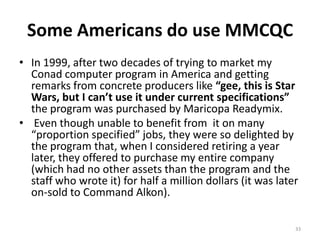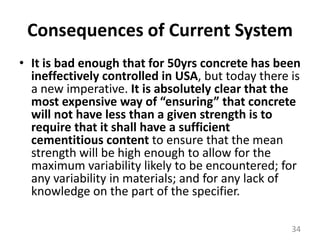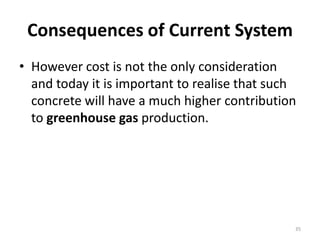P2 P
- 1. P2P: The Australian ExperienceBy Ken W. DayFACIConsulting Concrete Technologist1
- 2. What Does It Mean?P2P means changing the basis of concrete specifications from a Prescription to a Properties criterion. Essentially, this means transferring responsibility for mixture design and quality control from the Purchaser of concrete to the Producer of that concrete. Concrete production in Australia has essentially been on that basis for more than 20 years, so the opportunity is available to examine the effects of such a change without having to first commit to it.2
- 3. The Australian systemThe Australian system has resulted in expert concrete producers, with well-equipped and suitably staffed laboratories, designing and controlling a range of mixes to meet specified requirements. 3
- 4. The Australian systemThe producers are required to prepare monthly reports on all mixes which are circulated to all purchasers. In the event of any marginally low result being predicted from early tests, the producer is required to inform the purchaser of the concrete in question. 4
- 5. The Australian systemProducers generally use a graphical and statistical control system on concrete and input materials which identifies any problem at an early stage. The better of such systems also monitor the performance of each individual testing officer and truck driver.5
- 6. NATA,the National Association of Testing AuthoritiesThe producerŌĆÖs laboratories and staff, and their entire records, and record keeping and control system, are subject to inspection by NATA, the National Association of Testing Authorities. This authority does have a permanent staff, a member of which accompanies assessors on assessment visits,but the actual assessors (of which the author was one) are honorary persons, usually in charge of other laboratories. They are therefore selected expert persons, awake to all possible problems, and well motivated to expose any inadequacies of their competitors.6
- 7. Independent TestingThe Australian Standard does provide for samples to be taken by independent laboratories, if desired by the purchaser of the concrete, but this has largely come to be regarded as unnecessary as problems are rare. What was useful initially was independent sampling of the same truck of concrete as tested by the producerŌĆÖs team. This was aimed at checking the producerŌĆÖs honesty and testing quality rather than his concrete quality. 7
- 8. Independent TestingAs a more economical option, on some projects the producerŌĆÖs team was required to cast a double set of cylinders at a nominated frequency and to deliver one set to an independent lab for testing (thus avoiding supplier complaints about sub-standard sampling, compaction, and care on site, by the independent labs). As an independent consultant I was employed to monitor and report on such testing on several major projects. 8
- 9. ŌĆ£Bad Concrete or Bad TestingŌĆØI was able to establish that most producerŌĆÖs labs operated at a higher standard than the independent labs. It seemed apparent that an independent lab had to be just good enough to attain registration, but that a producerŌĆÖs lab could show a financial benefit by being absolutely top class. This gave rise to the paper ŌĆ£Bad Concrete or Bad TestingŌĆØ presented to ACI San Diego in 1989 (still available on my website www.kenday.id.au). 9
- 10. Concrete QC in USAIn USA, it is still normal for actual mix proportions (and ingredients) to be specified by the purchaser of the concrete and for the concrete to be tested by independent laboratories. There is therefore no financial benefit to be gained by the producer by acquiring skill in mix design or quality control,operating his own testing laboratory, or acquiring an effective control system.10
- 11. Concrete QC in USAThe result is that typical concrete variability (standard deviation) of strength in USA is of the order of 600 to 800psi compared to 250 to 400psi in Australia, and coefficient of variation is considered to be a better measure in USA (but not in Australia) ŌĆō which means that America is even less able to control high-strength concrete. In addition, minimum cement contents are often specified, along with requirements such as use of a natural sand.11
- 12. Comparative Effect of SpecificationsThis problem is intensified, and the incentive to achieve low variability further reduced, by the American use of a 10% defective criterion compared to the 5% criterion normal in the rest of the world. This has the effect of a reduced margin, and a typically higher variability resulting in a greater spread of results below the specified limit. 12
- 13. Comparative Effect of SpecificationsIt does not even save cement because the Australian margin of 1.65SD requires typically 1.65x300psi (= 495psi) while the US specifier must allow for more than twice the SD or say a margin of 1.28x700psi (= 896psi). Even so, if we consider the possibility of an occasional result two SDs below the mean, this will be 2x700-896 = 504psi below the specified strength for the US case and 2x300-495 = 105psi below the specified strength in the Australian case.13
- 14. Greenhouse Gas SituationIn this time of concern about the greenhouse gas generated by cement, it should be realised that there is no more wasteful way of ensuring the concrete is of sufficient strength than to specify mixture proportions which allow for both the highest variability likely to be experienced by an un-motivated producer, and the uncertainty of material properties and mix design skill of the specifier. 14
- 15. Deming, Shewhart, and JuranBasic Quality Control was an almost exclusively American development in the 1930s and 40s by Deming, Shewhart, and Juran, but their excellent work has had no influence on current practice in USA and these gentlemen would be appalled at the current provisions in ACI.One of the most basic principles of QC is:ŌĆ£The only legitimate purpose of any but 100% testing (of any product, not just concrete) is to establish the average quality and variability of the whole productionŌĆØ.15
- 16. Advice IgnoredA quote from one of my own papers (to ACI San Diego in 1989) was: ŌĆ£We must cease to think of a single test result as an invariably accurate judgement as to whether a particular truck of concrete is or is not acceptable.In the first place it may well not be accurate, and in the second we should show as much concern for those trucks we did not test as for those we did test. 16
- 17. The True Purpose of TestingRather we should regard the analysed pattern of test results as an important part (but only part) of the evidence we require in order to establish whether the totality of concrete being delivered to our project (or leaving our plant) is or is not satisfactory.ŌĆØ17
- 18. What is the Reason for the Delay?If it is accepted that the situation in Australia is far preferable to that current in USA, the question is why the Australian system should not be adopted by USA. To some extent a ŌĆ£chicken and eggŌĆØ situation is seen to exist, with US specifiers saying they would be happy with producers controlling their concrete if they were as competent and well equipped as Australian producers,and producers saying they would be happy to establish competently staffed, high standard, laboratories if specifications allowed them to profit thereby. . 18
- 19. Expertise is available hereThis is no longer a reasonable objection because some US producers are already in a position to immediately provide satisfactory control (if only because several are subsidiaries, or in some cases even owners, of Australian producers), the largest and most advanced purveyor of control system software (Command Alkon) is in fact American, and many US producers have already purchased such software19
- 20. The Real Pre-RequisiteThe only essential pre-cursor to producer control is the establishment of a service similar to the Australian NATA (National Association of Testing Authorities). There is ample expertise available in USA to staff such a service although, for a temporary initial period, a large proportion of assessors may have to be from government sources. Such a service is in any case badly needed in USA where complaints of both sub-standard testing and dishonest reporting occur20
- 21. Initiating P2PSo it is hopefully now clear that control ought to be undertaken by the producers, although they may initially require external assistance. (e.g. I have operated control systems for contactors in S.E. Asia on the basis of faxed test data (before the availability of email) from my office in Australia until they gained sufficient experience to take over, 21
- 22. Multigrade, Multivariable, Cusum QC (MMCQC)What makes a system effective is to get the maximum amount of analysable data into it and to analyse it promptly. There is no effective substitute for Multigrade, Multivariable, Cusum QC (MMCQC). Results must be entered into the system as soon as they are obtained and a complete initial analysis takes only a few seconds at the end of each dayŌĆÖs entry of results. 22
- 23. Early Detection of ProblemsAn important item on result entry and analysis is the unit weight of test cylinders. This can be available when cylinders arrive at the laboratory the day following casting. Entering unit weight along with slump and concrete temperature will frequently give a warning of any strength downturn six days before a 7day compression test.23
- 24. Testing Error ControlAnother important Cusum graph is of the pair difference of 28day cylinders, The average pair difference divided by 1.13 gives the ŌĆ£within sample standard deviationŌĆØ which could be regarded as the testing error. 75 to 150psi average difference represents good testing, but an average of much less than 75psi should be regarded with suspicion of malpractice.An average difference of 250psi or more is unacceptable and should lead to re-training of QC personnel24
- 25. Individual TO Performance. Average pair difference should be regarded as a property of each individual testing officer and I found it useful, when I owned a laboratory, to keep graphs of each individual TOŌĆÖs weekly average prominently displayed on the laboratory wall.(no-one wanted to be seen as least competent)25
- 26. Detection of Cause of DownturnMultivariable graphing enables the operator to see the cause of strength variation in other graphs such as slump, unit weight and concrete temperature and also to confirm that the variation was genuine rather than a statistical variation or testing error. The full Conad system provides for up to 60 possible graphs (up to 8 at a time).26
- 27. Cusum (cumulative sum) graphingCusum (cumulative sum) graphing typically detects change two to three times faster than normal (Shewhart) graphing but an even more important property is that it enables a facility to plot results from multiple grades of concrete on the same graph. This actually speeds and simplifies the analysis process in addition to providing much more rapid detection by typically getting several times as many results on the graphs. 27
- 28. Check on Low volume MixesHowever it is still necessary to have the system automatically analyse all results daily in their individual grades, outputting a table of all grades arranged in order of departure from required mean strength. This is to ensure that no unsatisfactory grade, represented by very few results (and therefore having little influence on the control graphs), escapes detection.28
- 29. Treatment of Low ResultsWe are now in a position to consider what would happen if an independent sample of concrete were taken and tested in Australia and gave an unacceptably low result (at either 7 or 28days).The producer would forward his own data including:Batch plant printout for the suspect loadTests on the Product Code in question on all sites, both on the day in question and for the past month (to show mix design acceptable).All tests on all sites for the day in question (to show no problems with materials)The producer would request information such as unit weight, slump, concrete temperature.29
- 30. Falsified Test DataThere have recently been cases of allegedly falsified test results in New York and elsewhere in USA. This does not happen in Australia. If one were to falsify a strength result there, it would either be obviously falsified, or it would be necessary to also falsify at least a dozen other items, including cylinder density and either slump or temperature; batch quantity records; sand gradings; early age tests, specimen collection and early curing etc. In other words concrete can be shown to be almost certainly sub-standard before a compression test result is even obtained and altering the test result alone would be quite obvious and unconvincing.30
- 31. Origination of Effective Concrete QCAs I am now 79 years of age, this presentation represents a last effort to overcome the ignorance and prejudice that has characterised official ACI provisions for the specification and control of concrete for the past 50years. In the early 1950s, in the UK, I used the published work of the US experts on QC in general to develop a control system for high strength precast, prestressed concrete involving statistical analysis (without even a hand calculator) and multi-variable graphing. This was operated by a junior clerical assistant, and enabled a Standard Deviation of less than 350psi to be maintained on concrete consistently averaging 9,800psi at 24hrs. 31
- 32. Attempts to Educate AmericaA paper ŌĆ£Specification of ConcreteŌĆØ was published in 1961. This paper, 50 yrs ago, covered most of the points I make here today, except for Cusum Analysis.In 1979 I delivered a paper ŌĆ£Quality Control of 55MPa Concrete for Collins Place Project, Melbourne. AustraliaŌĆØ to the ACI Milwaukee Convention, which did include Cusum Analysis.I published a series of 10 articles in Concrete International in the late 1980s covering the use of Lotus 123 spreadsheets for concrete QC. ACI considered these worthwhile re-publishing as Special Publication 13 in 1991.The above are only a few of the many publications on my website: www.kenday.id.au which make it abundantly clear that ACI Standards on the specification and control of concrete are woefully out of date and have completely ignored major developments.32
- 33. Some Americans do use MMCQCIn 1999, after two decades of trying to market my Conad computer program in America and getting remarks from concrete producers like ŌĆ£gee, this is Star Wars, but I canŌĆÖt use it under current specificationsŌĆØ the program was purchased by Maricopa Readymix.Even though unable to benefit from it on many ŌĆ£proportion specifiedŌĆØ jobs, they were so delighted by the program that, when I considered retiring a year later, they offered to purchase my entire company (which had no other assets than the program and the staff who wrote it) for half a million dollars (it was later on-sold to Command Alkon). 33
- 34. Consequences of Current SystemIt is bad enough that for 50yrs concrete has been ineffectively controlled in USA, but today there is a new imperative. It is absolutely clear that the most expensive way of ŌĆ£ensuringŌĆØ that concrete will not have less than a given strength is to require that it shall have a sufficient cementitious content to ensure that the mean strength will be high enough to allow for the maximum variability likely to be encountered; for any variability in materials; and for any lack of knowledge on the part of the specifier.34
- 35. Consequences of Current SystemHowever cost is not the only consideration and today it is important to realise that such concrete will have a much higher contribution to greenhouse gas production. 35
- 36. International EffectIt should also be realised that ACI has a substantial reputation in much of the world so that substantial harm is being done by it setting a poor example through its outdated concepts of QC.Over many years I have addressed groups in 23 countries on the subject of QC and it does not help to have to tell them that most ACI members are still doing what they did 50 years ago, even though a better system exists.36
- 37. Root Cause of ProblemThe problem is that consulting engineers who are ACI members seem reluctant to lose their right to specify detailed concrete mixes, Even though this is clearly counter-productive for their clients ŌĆō or perhaps they just donŌĆÖt understand the situation.Whatever their reason, consulting engineers should not stand in the way of providing well-controlled concrete that is both more economical and sustainable.37
